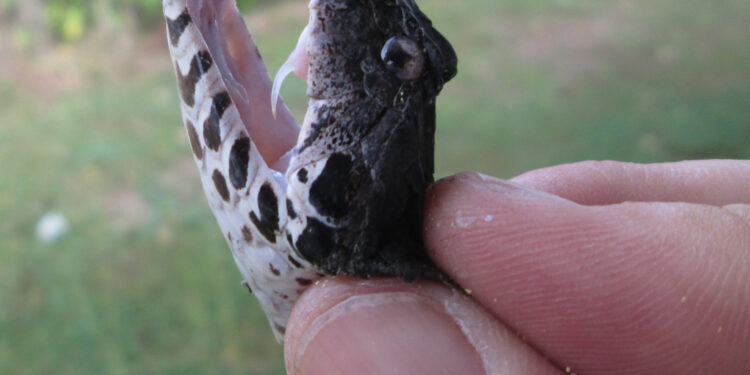The death adder, one of the most venomous snakes in the world. Credit: Christopher C. Austin.
Only 10 percent of the world’s roughly 4,000 snake species have venom potent enough to seriously injure a human, but that’s enough to make snakebites a significant public health problem. To better understand how snakes make their venom and how venoms differ between species, researchers have developed a new method to focus on the genes that snakes use to produce venom. Their work was published in the journal Molecular Ecology Resources.
“We developed a tool that can tell us which venom-producing genes are present in an entire family of snakes in one fell swoop,” says Sara Ruane, assistant curator of herpetology at the Field Museum’s Negaunee Integrative Research Center and lead author of the study.
All living things contain DNA, a molecule that provides chemical instructions for building and functioning an organism’s body. These instructions are called a genome, and the smallest sections of the genome are called genes. The human genome, for example, is made up of about 20,000 genes, which contain instructions for everything from cell growth to eye color.
In snakes, thousands of genes are involved in venom production, and different species of venomous snakes use different combinations and versions of these genes to produce their toxins.
“It’s important to know what’s in a snake’s venom because each type of venom has different effects: some affect the nervous system, others the circulatory system, and others cellular function,” Ruane says. “Knowing the composition of a certain type of venom can help develop an antivenom to treat that type of snakebite.”
Additionally, snake venoms contain compounds that are actually used in pharmaceutical development and human medicine. For example, the first ACE inhibitor drug to treat high blood pressure was created from a compound found in the venom of a Brazilian pit viper.
“You can harness the power of death in a controlled way,” Ruane explains.
Because there are thousands of genes that produce venom, and each snake’s genome contains tens of thousands of genes, it can be difficult to determine which ones are present for venom production in a given species. To solve this problem, Ruane and colleagues, led by the study’s first author Scott Travers, developed a technique called VenomCap.
VenomCap is a set of exon capture probes, which are groups of molecules designed to interact with a specific group of genes. VenomCap was designed to bind to any of the thousands of genes that previous studies have shown are involved in venom production in snakes.
Rather than having to sequence a snake’s entire genome (a time-consuming and expensive process) and combing through it to find more than 2,000 genes that could produce venom, VenomCap could provide scientists with a faster, easier way to see which of those genes a snake has.
To test VenomCap’s ability to bind to venom-producing genes, the researchers took tissue samples from 24 species of snakes in the medically important Elapidae family, which includes cobras, mambas and coral snakes.
Previous genomic studies have already identified many venom-producing genes in these snakes, and VenomCap was able to match those results, on average, with 76% accuracy. VenomCap can be used with tissue previously collected from anywhere in a snake’s body, rather than having to come directly from venom glands, which is another commonly used technique for determining venom genes in snakes.
Because VenomCap can be used to analyze the venom genes of individual species across the entire elapid family (about 400 species), it could make it easier for scientists to study the relationships between these snakes’ lifestyles and the venoms they produce.
“Let’s say you’re interested in closely related snake species that look similar, live in different environments, and eat different things. VenomCap could help scientists compare the venoms that these snakes produce, and that could help answer broader questions about whether the venoms evolve to fit the snakes’ lifestyles, or whether their lifestyles evolve to fit the venom they produce,” Ruane says.
In addition to shedding light on snake evolution, a tool like VenomCap could make a difference for scientists trying to treat dangerous snakebites.
“Snakebites are considered a neglected disease globally. In the United States, we don’t come into contact with venomous snakes very often, and when we do, we have extremely effective medical treatment. If you get to the hospital quickly because of a snakebite, you’re almost certainly not going to die,” Ruane says.
“But in other parts of the world, the hospital may be too far away to reach in time, or they may not have the right type of antivenom because there is very little of it. So any kind of work that studies snake venom and helps us identify the venoms that are present in different species can be extremely important in providing baseline data to develop effective treatments.”
More information:
VenomCap: a set of exon capture probes for targeted sequencing of snake venom genes, Molecular Ecology Resources (2024).
Quote:New technique focuses on genes that snakes use to produce venom (2024, September 19) retrieved September 19, 2024 from
This document is subject to copyright. Apart from any fair dealing for the purpose of private study or research, no part may be reproduced without written permission. The content is provided for informational purposes only.



